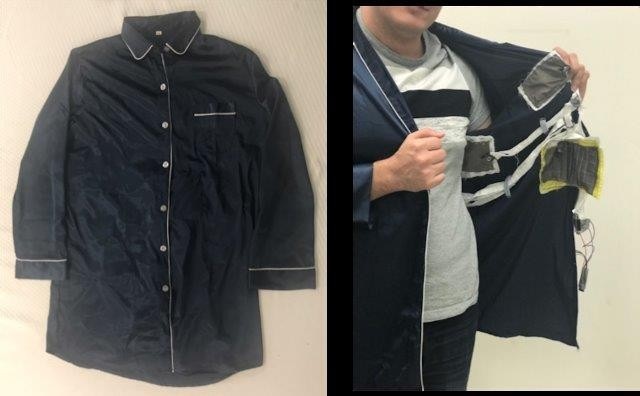Apr 2 2019
If anyone has ever imagined about getting a good night’s sleep, in the future, the solution may lie in data generated from one’s sleepwear.
 Ordinary-looking pajamas are transformed into “smart” ones with five strategically placed sensors that measure heartbeat, respiration, and posture. (Image credit: Trisha L. Andrew)
Ordinary-looking pajamas are transformed into “smart” ones with five strategically placed sensors that measure heartbeat, respiration, and posture. (Image credit: Trisha L. Andrew)
Scientists have designed pajamas equipped with self-powered sensors that enable continuous and unobtrusive monitoring of breathing, heartbeat, and sleep posture—factors that have a vital role to play in how well a person sleeps. The “smart” garments could offer ordinary people, and even clinicians, useful information that would help enhance their sleep patterns.
The scientists presented the study outcomes at the American Chemical Society (ACS) Spring 2019 National Meeting & Exposition on April 1st, 2019. ACS, one of the largest scientific society in the world, is organizing the meeting from April 1st to 4th, featuring almost 13,000 presentations on an extensive range of science topics.
“Our smart pajamas overcame numerous technical challenges. We had to inconspicuously integrate sensing elements and portable power sources into everyday garments, while maintaining the weight, feel, comfort, function and ruggedness of familiar clothes and fabrics. We also worked with computer scientists and electrical engineers to process the myriad signals coming from the sensors so that we had clear and easy-to-understand information.”
Trisha L. Andrew, PhD, Study Lead Author, University of Massachusetts, Amherst
The National Institutes of Health reports that getting ample quality sleep can help protect humans against infections, stress, and various diseases, such as high blood pressure, heart and kidney disease, and diabetes. Studies have discovered that quality sleep also enhances mental acuity and sharpens decision-making skills. However, a majority of the people do not get adequate sleep, or the quality one.
The National Sleep Foundation has predicted that the sleep industry is booming, costing almost $29 billion in 2017. Despite certain smart mattresses manufacturers claim the products have the potential to sense movement and guess the sleep posture, they do not offer detailed information related to the sleeper and are not portable. Commercially available electronic bands that are worn on the wrist provide information related to heart rate and monitor the total amount of sleep the wearer gets. However, to date, there has been no device that can be used by a typical consumer to monitor posture as well as respiratory and cardiac signals while sleeping.
Central to the smart pajamas is a process known as reactive vapor deposition.
“This method allows us to synthesize a polymer and simultaneously deposit it directly on the fabric in the vapor phase to form various electronic components and, ultimately, integrated sensors. Unlike most electronic wearables, the vapor-deposited electronic polymer films are wash-and-wear stable, and they withstand mechanically demanding textile manufacturing routines.”
Trisha L. Andrew, PhD, Study Lead Author, University of Massachusetts, Amherst
Termed “Phyjama” by the University of Massachusetts, Amherst researchers, the device has five discrete textile patches with sensors outfitted in them. Silver-plated nylon threads shielded in cotton are used to interconnect the patches. Wires from each patch terminate at a button-sized printed circuit board positioned at the same location as a pajama button. Data are wirelessly transmitted to a receiver through a small Bluetooth transmitter, which is part of the circuitry in the button.
The garment includes two kinds of sensors that are self-powered and detect “ballistic movements,” or changes in pressure. Of the patches, four are piezoelectric. They detect constant pressures, for instance, that of a bed against the body of a person. These patches, which are first-of-their-kind, are used in different parts of the Phyjama to enable the researchers to identify the sleeping posture.
But a sensor of this type cannot detect the faint pressure from a beating heart. The triboelectric patch picks up rapid changes in pressure, for instance, the physical pumping of the heart, thereby offering information related to heart rate. This is the first time such a sensor has been demonstrated to pick up minuscule ballistic signals from the heart.
Andrew and her colleagues have tested the garment on volunteers and confirmed the readings from the sensors independently. In addition, they have applied for patents on the Phyjama. Once Andrew partners with a manufacturer, she predicts that the product could be on the market within two years for a cost of $100–$200.
At present, the researchers are striving to extend the technology to wearable electronic sensors that pick up gait and send feedback to a monitor to assist in preventing falls. According to Andrew, this application could be used in settings like retirement centers and nursing homes.
Support and funding from the U.S. Air Force Office of Scientific Research and the David and Lucile Packard Foundation are acknowledged by the team.
Smart Garments - Headline Science
Video credit: American Chemical Society